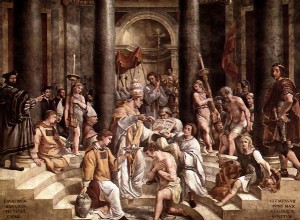 Oppidum is a Latin term which designates the fortified places of the Gauls. Originally used only in case of danger, an oppidum corresponds to a simple fortified refuge:it can be protected by favorable hydrography (Lutèce, on the current site of Paris), by swamps (Alesia) or by a relief in overhang (Bibracte at the top of Mont Beuvray in the Morvan). Subsequently, the oppidum became an industrial site where arms manufacturers remained, then a center of commerce, where craftsmen, traders and even peasants lived. These are often large towns. During the Roman conquest, Julius Caesar applied this term to Celtic cities in Gaul, the remains of which are still designated as such in archeology today.
Oppidum is a Latin term which designates the fortified places of the Gauls. Originally used only in case of danger, an oppidum corresponds to a simple fortified refuge:it can be protected by favorable hydrography (Lutèce, on the current site of Paris), by swamps (Alesia) or by a relief in overhang (Bibracte at the top of Mont Beuvray in the Morvan). Subsequently, the oppidum became an industrial site where arms manufacturers remained, then a center of commerce, where craftsmen, traders and even peasants lived. These are often large towns. During the Roman conquest, Julius Caesar applied this term to Celtic cities in Gaul, the remains of which are still designated as such in archeology today.
On the migration and settlement of the Celts in Gaul
Around the 2nd century BC. J.-C., the Celtic peoples stop their migration in various parts of Europe. In Gaul, they built their first cities, the oppidums. Some cities result from the transformation or displacement of a village. Others are founded in a place where no agglomeration existed before.
The foundation and development of these settlements are generally attributed to two events:the invasion of the Cimbri and the Teutons in Gaul towards the end of the 2nd century BC. J.-C., on the one hand, and the creation of the Roman province of Narbonnaise, on the other hand. The first amplified the need for protection. The second allowed the Gauls to observe Roman cities before reproducing them. We know today, thanks to in-depth archaeological excavations, that the creation and development of these cities respond to profound changes in Gallic society.
Building the Oppidums
 The towns are protected by walls of wood and stone, and extend over several hundred hectares . The houses are rectangular, about ten meters on each side. They consist of a wooden frame and wattle panels covered with clay. The streets intersect at right angles. The excavations of cities such as Villeneuve-Saint-Germain have highlighted a specialization of certain districts, for example craftsmen working with skin, textiles or metal. Oppidums sometimes include an unbuilt space, serving as a refuge for the surrounding population and livestock in case of danger.
The towns are protected by walls of wood and stone, and extend over several hundred hectares . The houses are rectangular, about ten meters on each side. They consist of a wooden frame and wattle panels covered with clay. The streets intersect at right angles. The excavations of cities such as Villeneuve-Saint-Germain have highlighted a specialization of certain districts, for example craftsmen working with skin, textiles or metal. Oppidums sometimes include an unbuilt space, serving as a refuge for the surrounding population and livestock in case of danger.
Around 100 BC. J.-C., the cities grow bigger and take more and more importance. They are real strongholds thanks to the protective walls built according to a Gallic technique. They are composed of dry stones reinforced with an interior framework of wood and iron, and are several meters thick. Most of the oppidums are adapted to the relief and located in height. They are usually on a hill whose connection with the plateau is only a thin flat ground. These protections are important against enemies. The walls are strong enough to withstand the Roman ramming.
The role of cities
In Caesar's Gallic Wars, the role of these cities seems essential since it is enough to take them for the entire population to surrender. True chief towns of a territory made up of villages and isolated farms, they are above all centers of commercial and political exchanges. Markets, meetings, fairs take place there. This economic role of the cities, associated with the need for protection against the enemy, seems to have dictated the location of the oppidums. Indeed, generally, their situation makes it possible to control important trade routes.
Some of these towns therefore turn out to be wealthy, like Bibracte, capital of the Aedui and place of mercantile exchanges with the Mediterranean world. These oppidums also conceal an important industrial activity. Raw materials and foodstuffs are produced in rural areas, while towns are full of craftsmen capable of manufacturing finished products (tools, utensils, fabrics, weapons, etc.).
An example of a Gallic oppidum:Bibracte
 Until 1853, researchers confused Bibracte, a city which, according to Julius Caesar, was "the most largest and richest city of the Aedui”, with Autun, built by the Romans. However, we were able to identify what we took for Roman camp ramparts as being the remains of the ancient capital. Since then, thanks to archaeological excavations, we know that Bibracte was a large urban center, completely surrounded by ramparts 5 to 6 km long.
Until 1853, researchers confused Bibracte, a city which, according to Julius Caesar, was "the most largest and richest city of the Aedui”, with Autun, built by the Romans. However, we were able to identify what we took for Roman camp ramparts as being the remains of the ancient capital. Since then, thanks to archaeological excavations, we know that Bibracte was a large urban center, completely surrounded by ramparts 5 to 6 km long.
This town was a perfect example of an oppidum. While in the other cities no vestige of habitat was discovered, because of their wooden constructions, the excavations on the mount Beuvray brought to light masonry houses having probably belonged to rich Aedui aristocrats. The wealth of this city comes from trade with the Mediterranean regions and from the metallurgical industry that developed there. Numerous traces of blacksmith workshops and ovens have been found, as well as a large forge, a complex of workshops forming an 80 m long building.
Oppidum Evolution
 With the appearance of the oppidums, there are essential changes in the organization of Celtic society. Gradually, hereditary royalty gave way to an oligarchic system. Power is exercised by influential noble families on which most of the population depends. In exchange for war services and the payment of taxes, they offer their legal protection. The more protected an aristocrat has, the more weight he has in society and gains in efficiency during trials. This privileged position allows these families to control the religious, political and economic life of Gallic society.
With the appearance of the oppidums, there are essential changes in the organization of Celtic society. Gradually, hereditary royalty gave way to an oligarchic system. Power is exercised by influential noble families on which most of the population depends. In exchange for war services and the payment of taxes, they offer their legal protection. The more protected an aristocrat has, the more weight he has in society and gains in efficiency during trials. This privileged position allows these families to control the religious, political and economic life of Gallic society.
We can notice two other essential changes:the birth of a Gallic cavalry and the absence of burial necropolises adjoining the oppidums. At the same time as the foundation of these villages, a permanent cavalry was created, whereas previously the troops were only raised temporarily. These new fighters are extensively trained and make war their profession. They fight for their city or for wealthy nobles. They are better equipped than their predecessors, armed with a long sword and protected by a helmet, a shield and even, sometimes, a coat of mail.
Near these urban centers, no trace of burials of the inhabitants has been found and it is assumed that they were simply cremated and their ashes were buried. The timing of this change corresponds perfectly with that of the appearance of the oppidums, which constitutes further tangible proof that the rise of these towns responded to a profound upheaval in Celtic society.
Celtic oppida also existed, between the 3rd and 1st centuries BC. AD, in many parts of Europe, from Ireland to Italy and from Spain to Hungary. They represent the oldest urban sites erected north of the Alps.
To go further
- The Gallic Civilization, by Renée Grimaud. West-France, 2013.
- A Gallic oppidum of the Alpilles:The Caisses of Jean Jean in Mouriès (Bouches-du-Rhône) 7th century BC - 3rd century AD.
- The oppidum of Bibracte:myths, archaeology, and legends of a Gallic site.




